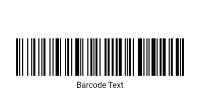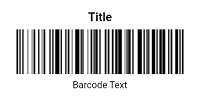The UPC-E barcode is a compressed version of the UPC-A symbology, designed to encode 6-digit numeric data in a more compact format. It is primarily used for smaller packages where space is limited, providing an efficient solution for product identification and retail operations.
UPC-E was introduced as a subset of the UPC (Universal Product Code) system in the 1970s to address the need for a more space-efficient barcode format. It was developed to complement the UPC-A system by offering a more compact representation of product codes while maintaining compatibility with existing retail systems.
Technical Specifications
UPC-E barcodes encode the same data as UPC-A but in a more compact form. The key features of UPC-E include:
- Data Compression: UPC-E reduces the length of the barcode from 12 digits in UPC-A to 6 digits by omitting leading zeros and compressing certain patterns of digits. This makes it suitable for smaller product labels.
- Encoding Format: The UPC-E barcode uses a reduced set of bars and spaces to represent numeric data. It supports the same numeric range as UPC-A but compresses the information to fit a smaller space.
- Compatibility: UPC-E barcodes can be converted to UPC-A barcodes for processing and scanning. Retail systems that support UPC-A can generally handle UPC-E barcodes as well.
Conversion Between UPC-E and UPC-A
UPC-E barcodes can be easily converted to UPC-A format and vice versa. The conversion process involves:
- From UPC-E to UPC-A: Expanding the compressed 6-digit code into a 12-digit UPC-A format by adding leading zeros and adjusting the digit patterns according to predefined rules.
- From UPC-A to UPC-E: Compressing the 12-digit UPC-A code into the 6-digit UPC-E format by removing leading zeros and applying compression rules.
This compatibility ensures that UPC-E can be used in systems originally designed for UPC-A, facilitating seamless integration.
Advantages and Disadvantages
The UPC-E barcode offers several advantages, including its compact size, which is beneficial for small or narrow packaging. It maintains compatibility with the broader UPC system, ensuring that it can be integrated with existing retail infrastructure.
However, UPC-E has limitations. The compression process can reduce the available numeric range, which might constrain the number of unique product identifiers. Additionally, while UPC-E is efficient for small labels, it may not provide the same level of detail as UPC-A for larger products.
UPC-E Applications
UPC-E is primarily used in retail environments where space on product packaging is limited. Common applications include:
- Retail Packaging: Ideal for small products or packaging where a full-length UPC-A barcode would be too large.
- Inventory Management: Provides a compact solution for product tracking and management, helping to maintain efficiency in inventory systems.
- Point-of-Sale Systems: Used at checkout counters where space on products is constrained, allowing for quick scanning and processing.
Comparison with Other Barcode Symbologies
Compared to UPC-A, UPC-E provides a more compact representation of the same data, making it suitable for smaller packaging. Unlike other barcodes such as Code 128, which supports a broader range of characters and data types, UPC-E is limited to numeric data and has a fixed length. It is also more space-efficient than UPC-A but may be less versatile in applications requiring more detailed information.
The UPC-E barcode is a practical extension of the UPC system, offering a space-efficient solution for encoding numeric data. Its development to complement UPC-A provides retailers with a way to manage product identification on smaller packages effectively. While its compact size and compatibility with existing systems make it a valuable tool in retail operations, its limitations in numeric range and detail should be considered when choosing the appropriate barcode format for specific applications.


